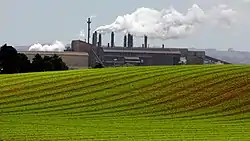Glenbrook, New Zealand
Glenbrook is a rural and industrial area in the Auckland region of New Zealand. The industrial area, that of New Zealand's major steel mill, New Zealand Steel, is not located close to any towns - the surrounding countryside is occupied by farms. The nearest towns are Waiuku, five kilometres to the south, and Pukekohe, 15 kilometres to the east.
Glenbrook | |
|---|---|
 The Glenbrook Steel Mill and surrounding farms | |
| Coordinates: 37°13′S 174°47′E | |
| Country | New Zealand |
| Region | Auckland Region |
| Ward | Franklin ward |
| Board | Franklin Local Board |
| Electorates | |
| Government | |
| • Territorial Authority | Auckland Council |
| Area | |
| • Total | 53.16 km2 (20.53 sq mi) |
| Population (June 2023)[2] | |
| • Total | 2,620 |
| • Density | 49/km2 (130/sq mi) |
Glenbrook's other claim to fame is the Glenbrook Vintage Railway.
History
Construction of the Glenbrook Steel Mill began in 1967.[3] Glenbrook was chosen as the site due to the area's proximity to the Waikato North Head ironsand mine and the Huntly Power Station.[4]
Demographics
Glenbrook statistical area, which includes Glenbrook Beach, covers 53.16 km2 (20.53 sq mi)[1] and had an estimated population of 2,620 as of June 2023,[2] with a population density of 49 people per km2.
| Year | Pop. | ±% p.a. |
|---|---|---|
| 2006 | 1,974 | — |
| 2013 | 2,034 | +0.43% |
| 2018 | 2,193 | +1.52% |
| Source: [5] | ||
Glenbrook had a population of 2,193 at the 2018 New Zealand census, an increase of 159 people (7.8%) since the 2013 census, and an increase of 219 people (11.1%) since the 2006 census. There were 741 households, comprising 1,110 males and 1,083 females, giving a sex ratio of 1.02 males per female. The median age was 44.4 years (compared with 37.4 years nationally), with 402 people (18.3%) aged under 15 years, 336 (15.3%) aged 15 to 29, 1,134 (51.7%) aged 30 to 64, and 324 (14.8%) aged 65 or older.
Ethnicities were 86.0% European/Pākehā, 10.8% Māori, 4.1% Pacific peoples, 8.5% Asian, and 1.8% other ethnicities. People may identify with more than one ethnicity.
The percentage of people born overseas was 19.7, compared with 27.1% nationally.
Although some people chose not to answer the census's question about religious affiliation, 59.0% had no religion, 28.2% were Christian, 0.7% had Māori religious beliefs, 0.5% were Hindu, 0.7% were Muslim, 0.5% were Buddhist and 1.9% had other religions.
Of those at least 15 years old, 285 (15.9%) people had a bachelor's or higher degree, and 303 (16.9%) people had no formal qualifications. The median income was $38,600, compared with $31,800 nationally. 420 people (23.5%) earned over $70,000 compared to 17.2% nationally. The employment status of those at least 15 was that 1,020 (57.0%) people were employed full-time, 261 (14.6%) were part-time, and 54 (3.0%) were unemployed.[5]
Education
Glenbrook School is a coeducational full primary school (years 1–8) with a roll of 280 as of April 2023.[6][7] The school opened in 1878.[8]
References
- "ArcGIS Web Application". statsnz.maps.arcgis.com. Retrieved 18 August 2022.
- "Population estimate tables - NZ.Stat". Statistics New Zealand. Retrieved 25 October 2023.
- "New Zealand Steel - History". New Zealand Steel Limited. 2011. Archived from the original on 26 February 2012. Retrieved 20 February 2012.
- Ingram, John (2011). "Steel from Ironsand". In La Roche, John (ed.). Evolving Auckland: The City's Engineering Heritage. Wily Publications. pp. 245–261. ISBN 9781927167038.
- "Statistical area 1 dataset for 2018 Census". Statistics New Zealand. March 2020. Glenbrook (162400). 2018 Census place summary: Glenbrook
- "New Zealand Schools Directory". New Zealand Ministry of Education. Retrieved 12 December 2022.
- Education Counts: Glenbrook School
- "Nau Mai, Haere Mai and Welcome - Glenbrook School 1876 – 2020". Glenbrook School. Retrieved 20 September 2020.